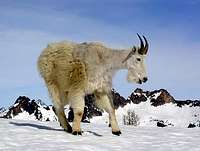-
 72796 Hits
72796 Hits
-
 94.63% Score
94.63% Score
-
 48 Votes
48 Votes
|
|
Mountain/Rock |
|---|---|
|
|
48.51200°N / 120.65546°W |
|
|
Mountaineering, Trad Climbing, Sport Climbing, Ice Climbing, Mixed |
|
|
Spring, Summer, Fall |
|
|
7807 ft / 2380 m |
|
|
Overview
South Early Winters Spire is the highest summit of the Liberty Bell Group. It is separated from the North Spire by a deep notch. The rock is excellent granite and there are routes on all sides of the peak. Two of these, the South Arete and the Southwest Couloir are among the most popular routes in the Liberty Bell Group. The spire was first climbed via the Southwest Couloir on July 20, 1937. A party of Kenneth Adam, Rafi Bedayn, and W. Kenneth Davis is credited in their report, but Beckey states that only the names Bedayn and Neil Ruge appear(ed) in the summit register.
Getting There
South Early Winters Spire is approached from the vicinity of Washington Pass on State Highway 20. The approach from the west starts at the Blue Lake Trailhead just west of the pass. Climbs on the east side are approached from the hairpin curve or several smaller parking spots just east of the pass. The easiest approach to the west side of the spire is from the Blue Lake Trailhead via the Blue Lake Trail to the climber's trail into the basin on the west side the Liberty Bell Group. From the Blue Lake Trailhead, follow the main trail about one and a half miles to the well-worn climber's trail and climb it into the basin. From there, scramble to the base of the tower.
It is also possible to reach west side from the hairpin curve to the east of Washington Pass. Climb to the top of the basin to the south of the Early Winters Spires, then traverse high along the base of the rock on the west. This approach is best done when the basin is still snow filled (taking care regarding avalanches) and is frequently used for ascents of the Southwest Couloir. Washington Department of Transportation web site with information and updates on the spring opening of Washington Pass: Washington Pass Information
Routes Overview
Beckey lists twelve separate routes on South Early Winters Spire. Most of these are difficult rock climbs of Grade III 5.10 and greater difficulty. The four routes listed here appear to be the most popular climbs on the peak. See Beckey's Rainy Pass to Fraser River Guide for detail on all the routes.
South Arete, Grade II, 5.5. This is probably the second most popular route in the Liberty Bell Group with the Beckey Route on Liberty Bell being number one. It would be a rare day to have this route to yourself. The route is not really on an arete. It is more a very steep ridge, and for most of the route the crest itself is not followed. Because it faces south -southwest, the route clears of snow and ice fairly early in the season. The first pitch is the hardest (5.5) with most of the rest of the route third and fourth class with the occasional fifth class move.
Southwest Couloir Grade II Snow and /or ice to 50 degrees and / or rock to class 4 depending on the season and time of year. This is an extremely popular early season snow and ice route with difficulties varying greatly depending on the year and time of year climbed. Late in the season, the couloir is filled with loose rock (Class 3 & 4) and though climbable, it is not recommended because of human caused rock fall.
Southwest Buttress / Rib Grade III 5.7 to 5.10 depending on variations. This route ascends the obvious buttress immediately north of the Southwest Couloir. The broad buttress consists of good rock and provides a variety of variations. Direct East Buttress Grade III+, 5.9 – A0 or 5.11, 9 pitches. A two and a half day climb on the first ascent by Fred Beckey and Doug Leen in 1968, the route is now commonly done in one day and is becoming quite popular. The rock is solid overall though covered in the “kitty litter” stuff (typical of some WA Pass routes) in places.
Red Tape and General Forest Information
Northwest Forest Pass is required to park at the Blue Lake Trailhead. The Okanogan National Forest web site has current information regarding obtaining a NW Forest Pass, road and trail conditions, closures, campgrounds, etc.: Okanogan National Forest
Goats
There are numerous mountain goats in the immediate area. Alway nice to see on a trip:
Camping
There are official USFS fee campgrounds on both sides of Washington Pass. The nearest is Lone Fir to the east with Klipchuck and Early Winters a bit further east, but at lower elevations and thus open earlier in the season. Some folks "bivouac" at the Blue Lake Trailhead or even at the hairpin curve. Suitable campsites can be found in the basin to the west of the rocks. See Getting There for the approach. Campground Information
Note on Spelling
Fred Beckey and others have published the names of the Early Winters Spires as the Early Winter Spires - no "s" on Winter. The official USGS name is Early Winters - with an "s" on Winters.













